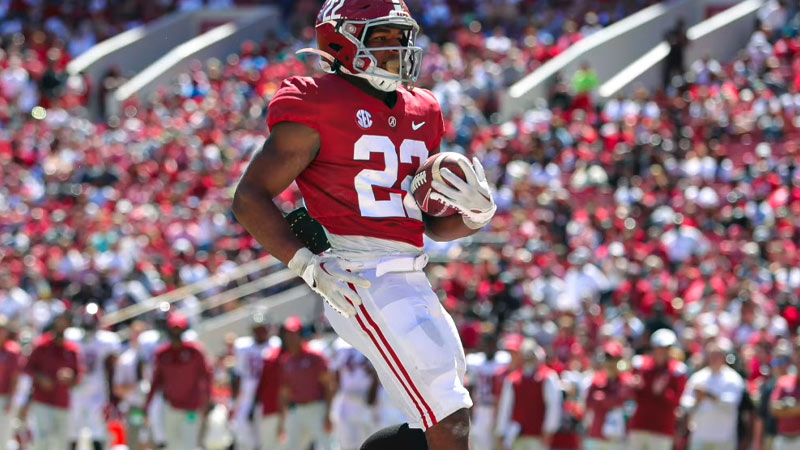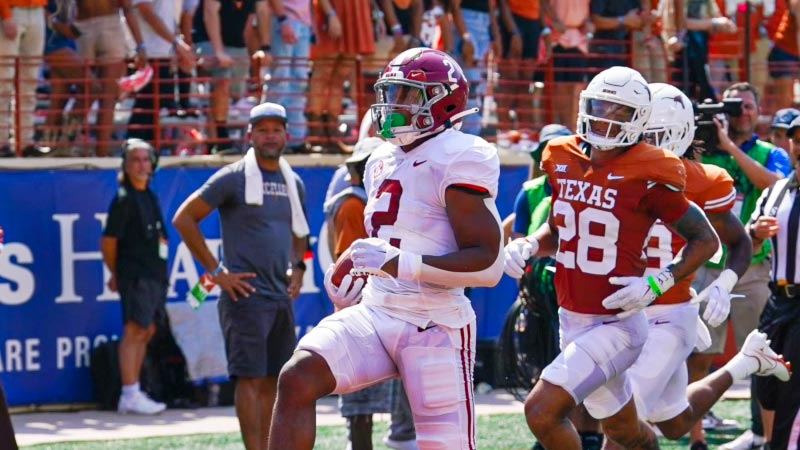In the dynamic and strategic world of American football, every position plays a unique role in shaping the outcome of the game. One such position that holds a crucial role in the offensive scheme is the football split end receiver.
This often unsung hero of the gridiron possesses the speed, agility, and strategic prowess to change the course of a match.
In this blog post, we’ll delve into the intricacies of the football split end receiver position, uncovering their responsibilities, impact on the game, and the strategies they employ to outmaneuver the opposition.
Whether you’re a passionate football enthusiast or just curious about the finer details of the game, this exploration will provide insights into the artistry behind this integral position. So, stay focused.
Who Is the Football Split End Receiver?
The football split end receiver is a crucial position in American football, often known simply as the “split end.” Positioned on the line of scrimmage, opposite the tight end, the split end is a wide receiver responsible for running precise routes, catching passes, and stretching the field vertically.
They typically possess exceptional speed, agility, and the ability to elude defenders. The split end’s primary objective is to create separation from defensive backs and make deep or intermediate receptions, thus contributing to their team’s offensive strategy.
This position requires strong hands, sharp route-running skills, and a deep understanding of the game’s strategic nuances. The split end’s success depends on teamwork with the quarterback, offensive line protection, and the coordination of the overall offensive scheme.
Responsibilities of Football Split End Receiver

The football split end receiver carries several key responsibilities that contribute to the team’s offensive success:
Route Running
The split end must be proficient in running a variety of routes, including deep vertical routes, comebacks, post routes, and slants. Precise route running helps create separation from defenders and provides options for the quarterback.
Creating Separation
The split end’s ability to outmaneuver defensive backs is crucial. Using speed, agility, and well-timed cuts, they aim to create space between themselves and the defender, making it easier for the quarterback to complete a pass.
Deep Threat
The split end often serves as the team’s deep threat, stretching the field vertically and forcing the defense to cover a larger area. This can open up opportunities for other receivers and running plays underneath.
Catching Passes
A reliable set of hands is essential for the split end. They must catch both contested and routine passes, helping to convert critical downs and maintain offensive momentum.
Blocking
While primarily a receiving position, the split end is also expected to contribute to blocking, especially during running plays. Blocking effectively can lead to bigger gains for the running back and improve overall offensive performance.
Adjusting to Defensive Schemes
The split end must read and react to the defense’s coverage schemes. They need to make split-second decisions based on how the defense is positioned, which impacts their route adjustments and positioning on the field.
Communication with the Quarterback
Establishing a strong rapport with the quarterback is vital. This involves understanding the quarterback’s preferences, reading their signals, and making split-second adjustments based on the evolving play.
Yards After Catch (YAC)
After catching a pass, the split end aims to gain additional yards by using their speed, agility, and vision to evade tacklers. Maximizing YAC can turn short completions into substantial gains.
Exploiting Defensive Weaknesses
The split end should be aware of the defense’s vulnerabilities and be ready to exploit them. Adjusting routes based on defensive alignments can lead to open passing lanes.
Situational Awareness
Whether it’s recognizing a crucial third-down situation or being aware of the clock, down, and distance, the split end must possess situational awareness to make strategic decisions during the game.
Positions of the Football Split-End Receivers

In American football, the positions of the split-end receiver can vary depending on the offensive formation and alignment. However, the primary position for the split-end receiver is typically as follows:
Alignment
The split-end receiver lines up on the line of scrimmage, positioned on the outermost part of the offensive formation, usually away from the tight end. They are often stationed on the same side as the offensive tackle but slightly wider out.
Stance
The split-end receiver typically uses a three-point stance, meaning they have three points of contact with the ground (one hand and two feet). This stance provides a good balance of explosiveness off the line of scrimmage and stability.
Distance from Line of Scrimmage
The split-end receiver’s alignment from the line of scrimmage can vary depending on the offensive system and play design. They often line up a few yards from the line to have space to build speed before the snap.
Route Tree
The split-end receiver runs a variety of routes depending on the offensive play call. These routes can include deep vertical routes, comebacks, post routes, corner routes, and other patterns that help stretch the field and create separation from defenders.
Blocking
While primarily known for their receiving abilities, split-end receivers are also expected to contribute to blocking, especially during running plays. They may engage with defensive backs or even linebackers to create running lanes for ballcarriers.
It’s important to note that the specific roles and alignments of football players can vary based on the team’s offensive scheme and the strategies employed by the coaching staff.
Impact of the Football Split-End Receiver
The football split end receiver has a significant impact on the team’s offensive performance and overall game strategy:
Vertical Threat
The split end’s ability to stretch the field vertically forces the defense to allocate resources to cover deep routes. This opens up opportunities for other receivers and creates space for running plays underneath.
Defensive Attention
Defenses must account for the split end’s speed and deep threat potential. This can lead to safety help over the top or adjustments in coverage, which in turn can create mismatches and open up possibilities for other offensive players.
Explosive Plays
With their speed and route-running skills, split-end receivers are often targeted for big plays downfield. Successfully connecting on these plays can lead to explosive gains and quick scoring opportunities.
Clearing Space
By demanding coverage downfield, the split end can clear out zones and open passing lanes for other receivers or running backs. This strategic effect helps the offense move the ball efficiently.
Decoy Role
Even if the split end isn’t the primary target on a play, their presence can draw defenders away from other parts of the field, creating opportunities for teammates to make receptions.
Red Zone Threat
The split end’s ability to win one-on-one battles and catch contested passes is valuable in the red zone. They can be targeted for fade routes or quick slants to score touchdowns.
Balancing the Field
The presence of a skilled split-end receiver provides offensive balance, preventing defenses from focusing solely on short or intermediate passes. This diversification keeps the defense guessing and allows the offense to exploit various parts of the field.
Clock Management
Effective play by the split end, whether it’s making catches along the sideline or gaining yards after the catch, can help control the clock and manage game tempo.
Game-Changing Moments
In critical situations or clutch moments, the split-end receiver’s ability to make a crucial catch or breakaway play can turn the tide of a game and determine the outcome.
Ripple Effect
The split end’s performance can impact the entire offensive unit’s confidence and energy. Successful plays can boost morale and lead to sustained offensive rhythm.
In essence, the football split end receiver’s impact extends beyond their individual statistics.
Their presence and performance influence defensive strategies, offensive play-calling, and the overall dynamics of the game, making them a pivotal part of a team’s offensive arsenal.
FAQs
What is the role of a football split end receiver?
The football split end receiver is a wide receiver positioned on the outermost part of the line of scrimmage.
Their primary responsibilities include running precise routes, creating separation from defenders, catching passes, and stretching the field vertically to open up offensive opportunities.
What makes the split end receiver a vital part of the offense?
The split-end receiver’s ability to serve as a deep threat forces the defense to allocate resources to cover deep routes, creating mismatches and opening up space for other offensive players.
Their impact extends to creating explosive plays, clearing zones for other receivers, and even acting as a decoy to distract defenders.
What skills are essential for a successful split end receiver?
A successful split-end receiver needs a combination of speed, agility, sharp route-running skills, reliable hands, and the ability to read and react to defensive coverage schemes.
Adaptability, strong communication with the quarterback, and situational awareness are also crucial traits.
How does the split end receiver impact red-zone situations?
In the red zone, the split end’s ability to win one-on-one battles and catch contested passes can be a game-changer. They can be targeted for fade routes or quick slants, making them a valuable asset when the offense is close to the end zone.
How does the split end receiver influence defensive strategies?
The presence of a skilled split-end receiver forces defenses to adjust their coverage schemes, often dedicating safety help over the top to counter the deep threat. This opens up opportunities for the offense to exploit other areas of the field and create favorable matchups.
Wrapping Up
The football split end receiver stands as a linchpin in the intricate tapestry of offensive gameplay.
Their ability to stretch the field, outmaneuver defenders, and create game-changing moments highlights the artistry that goes into each play. From deep routes to critical red zone situations, the split end receiver’s impact ripples across the entire game.
By understanding their responsibilities and influence, we gain a deeper appreciation for the strategic chess match that unfolds on the football field, where every position has its unique role in shaping the outcome of the game. Best wishes.







